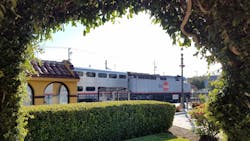Caltrain to run more service than ever
Beginning Aug. 30, Caltrain will surpass its pre-pandemic levels of service, offering 104 trains per weekday, including hourly all-stop Local trains throughout the day and the return of the Baby Bullet express trains.
As an additional incentive to riders, Caltrain is discounting all its non-Go Pass fares by 50 percent during the month of September.
The new level of weekday service, higher than any point in Caltrain’s history, will provide increased service and frequency throughout the day and into the evening. Service during the weekday peak commuting hours (6:00 a.m. to 9:00 a.m., 4:00 p.m. to 7:00 p.m.) will be increased to four trains per hour with the return of hourly Baby Bullet express trains.
Limited-Stop train service during the middle of the day will provide riders with a faster alternative, while half hourly service until 11:00 p.m. will provide better local service into the late evenings, in keeping with the goals of the Framework for Equity, Connectivity, Recovery and Growth.
Another goal of the framework captured by the new schedule is a move towards clock-face scheduling, so trains arrive at regular and predictable intervals, simplifying the riding experience.
The restoration of the third Gilroy train, which includes direct service to College Park station, will provide increased service to South Bay residents. Weekend service will now be identical, rather than separate Saturday and Sunday schedules, which adds two additional round trips in the morning and late evening on Sundays.
Caltrain developed the timetable with an emphasis on improving Bay Area Rapid Transit connections at the Millbrae Transit Center. Under the new timetable, most connections during weekdays are between eight and 15 minutes, just right for rider convenience while flexible enough to avoid missing transfers. After 8:30 p.m. and for some weekend transfers, the wait time is currently less optimal. Both systems are dealing with intensive, system-wide construction, rebuilding and maintenance activities that limit flexibility, and are continuing to work together to optimize connections.
As public health conditions continue to evolve and ridership continues to increase, Caltrain says it will make further service adjustments to meet the public’s changing transportation needs. Caltrain ridership continues to improve, regularly exceeding 12 percent of pre-pandemic levels on the weekdays and 40 percent on the weekends.
